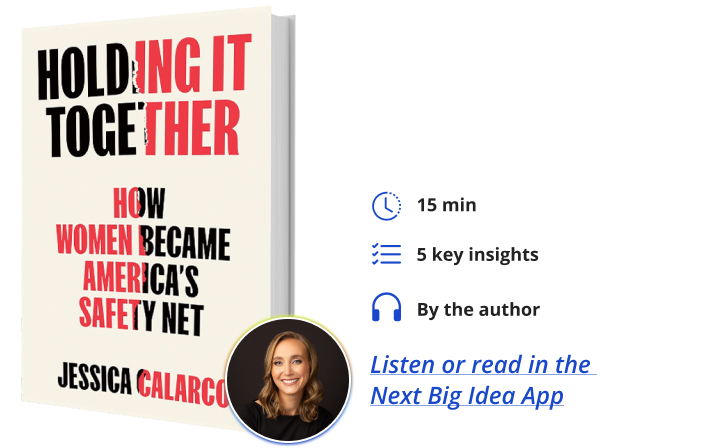Jessica Calarco is a professor of sociology at the University of Wisconsin, an expert on families, schools, and inequalities, and a mom of two. She is the author of Negotiating Opportunities and A Field Guide to Grad School, the coauthor of Qualitative Literacy, and a contributor to The New York Times, The Atlantic, and The Washington Post.
Below, Jessica shares five key insights from her new book, Holding It Together: How Women Became America’s Safety Net. Listen to the audio version—read by Jessica herself—in the Next Big Idea App.

1. The US tries to DIY society by treating women as its invisible glue.
Other countries have invested in social safety nets to help people manage risk. They use taxes and regulations, especially on wealthy people and corporations, to protect people from falling into poverty, give people a leg up in reaching economic opportunities, and help people live with dignity regardless of how much money they earn. In the US, we’ve tried to DIY society. We’ve kept taxes low, slashed huge holes in our meager safety net, and told people that if they made “good choices,” they wouldn’t need government support at all. Now, the problem is that you can’t actually DIY society—forcing people to manage all that risk on their own has left many American families and communities teetering on the edge of collapse. And yet, we haven’t collapsed because women are holding it together, filling in the gaps in our economy and the gaps in our threadbare safety net.
2. Our DIY society is crushing women and their families and communities too.
Take, for example, the story of a woman I’ll call Akari—one of the hundreds of moms who participated in the research that went into this book. Akari and her partner Theo met in college but both dropped out when the costs got too high. Theo started his own home maintenance business, which brought in about $30,000 a year, and Akari helped Theo manage the business while also working part-time in retail.
That arrangement worked fairly well until their daughter Mei was born in 2015. They didn’t have family or friends who could provide childcare, and they made too much to qualify for subsidies but not enough to afford the full price of care. So, Akari became a stay-at-home mom and a pretty typical one—typical in the sense that almost 75 percent of American stay-at-home moms have household incomes less than $50,000 a year. Akari remained a stay-at-home mom until the summer of 2020, when Theo died suddenly and unexpectedly.
Like roughly half of all US adults, Theo didn’t have any life insurance, and the little they had in savings wasn’t enough to keep paying rent. Akari wanted to find a job so they could stay in their apartment, but local childcare centers were all closed because of the pandemic, and most local businesses were laying people off. So Akari applied for welfare and food stamps and moved herself and the kids into a shelter, where they stayed for a few months before eventually getting a spot in public housing. Relying on public assistance was challenging for Akari emotionally. Akari never knew anyone on welfare, and she felt guilty about relying on what she called “other people’s tax money.” Yet, the maximum Akari could get from welfare was only $288 a month. And even with extra support in the form of Medicaid, food stamps, and subsidized housing and childcare, Akari rarely had enough to make ends meet.
“They didn’t have family or friends who could provide childcare, and they made too much to qualify for subsidies but not enough to afford the full price of care.”
Meanwhile, adding insult to injury, Akari’s welfare benefits required that she find paid work, even though her welfare benefits would be docked for every dollar she earned. So Akari took the first job available—a no-benefits part-time job in retail, which paid less than $10 an hour. Akari added a second low-wage part-time job in early 2021, but she still rarely got enough hours to make ends meet. She also took a third job at a manufacturing facility, working 12-hour shifts on Saturdays and Sundays. To make that job work childcare-wise, the kids spend weekends at Theo’s sister’s house—because of the commute time, it doesn’t make sense for Akari to pick them up and drop them off both days. Akari hates that she doesn’t get to spend the weekends with her kids, and she can see the toll her absence takes on them.
“My daughter,” Akari told me, “has PTSD because of her father’s death. She went from having a dad who works and being a daddy’s girl and having a stay-at-home mom who always cared for her. And now there’s no dad, and mom’s always working. So, in her mind, she lost both parents.” That sacrifice has been devastating for Akari, but it hasn’t left her much better off financially because taking a third job pushed her over the benefits cliff. “There’s not really a nice transition,” Akari told me, saying she would be better off in the short term quitting her third job and going back on welfare. Yet Akari knew the clock was ticking. Indiana’s lifetime cap on welfare eligibility is two years for adults and five years for kids—though soft diversion tactics ensure that almost no one stays in that long. She told me: “Welfare’s not gonna last forever and I’m just gonna get older. Right now I can work but what am I gonna do when I’m sixty, you know? I can’t have anything saved up if I’m on welfare. You can’t move up. You have to stay within that line. Right now where I’m at I lost all my welfare services. But if I continue to work eventually I can maybe get a raise.”
Akari’s story raises questions about why the US hasn’t invested in building a stronger and less punitive social safety net.
3. The DIY illusion benefits billionaires and big corporations.
As I explain in Holding It Together, the roots of our DIY society stretch back in part to the 1930s and to the efforts of business elites to challenge Franklin Roosevelt’s New Deal. At the time, the members of the National Association of Manufacturers didn’t want to pay the higher taxes required to fund large-scale government programs. And so they began looking for a way to persuade people that the US didn’t need a safety net. What they found was a group of Austrian economists who were developing a set of neoliberal economic theories. These economists argued that societies will be better off without strong social safety nets because, in the absence of government protection, people will be more inclined to make the so-called “good choices” needed to keep themselves safe.
“The reality is that pulling ourselves up by our bootstraps is impossible.”
Now, this theory has been thoroughly debunked by evidence. But at the time, and for the National Association of Manufacturers members, it had an alluring appeal. And so those corporate elites paid American universities to hire the Austrian economists who developed neoliberalism and to train the next generation of economists, policymakers, and business leaders in the US. Going a step further, those corporate elites also worked with economists like Milton Friedman to bankroll massive propaganda campaigns. Those campaigns included the popular television program General Electric Theater, hosted by Ronald Reagan, which glorified the idea of a DIY society, telling uplifting (though fictional) stories of people pulling themselves out of difficult situations simply by working hard and making the right choice.
Of course, the reality is that pulling ourselves up by our bootstraps is impossible. This raises questions about why women don’t simply refuse to do this work, which brings us to our fourth key insight.
4. We force women to fill in the gaps by turning motherhood into a trap that leaves them with nowhere to turn and nowhere to hide.
In the presence of anti-abortion norms and regulations, anyone who can become pregnant can be easily forced into motherhood. And in the absence of universal childcare and paid family leave, motherhood can often leave women, especially low-income, with no choice but to stand in for the social safety net. Take, for example, a young woman I’ll call Brooke. Home wasn’t a happy place for Brooke growing up. Given her upbringing and her parents’ volatile relationship, Brooke never wanted to have kids. And then, she accidentally got pregnant in college. Brooke and her boyfriend, Brendan, initially planned to get an abortion, and Brendan’s parents even offered to pay. But then Brooke’s parents found out. Brooke’s mom persuaded Brooke to get an ultrasound and to keep the baby, promising that Brooke and the baby could live at home and that she would help raise the baby so Brooke could finish college.
Once her son Carter was born, however, Brooke’s parents told her they couldn’t afford to pay for both college and childcare. Without childcare, it was hard for Brooke to keep up with her schoolwork. And she couldn’t take night classes because she didn’t trust her parents to watch Carter. So, Brooke dropped out of college and moved into a women’s shelter since being on her own would make it easier to qualify for a subsidized apartment and programs like welfare, WIC, and subsidized childcare.
Since welfare came with work requirements, Brooke also took the first job she could find—a minimum-wage job in retail at the same store as her mom. Brooke hated the job and complained about it to the director of Carter’s childcare center, who saw Brooke’s unhappiness as an opportunity. The center was struggling with staff turnover. So, the director begged Brooke to come on board. The job at the center only paid minimum wage, but it came with free childcare, which was costing Brooke nearly as much as rent.
Brooke took the job, and loved working with kids. But money remained a constant challenge. Even when she got promoted to assistant director of the center a few years later, Brooke’s salary was only $25,000 a year. Given the precarity of her situation, Brooke thought about trying to go back to college to get a nursing degree But, Brooke just couldn’t figure out how to make it work. So, she kept working at the childcare center.
“Brooke hated the job and complained about it to the director of Carter’s childcare center, who saw Brooke’s unhappiness as an opportunity.”
Brooke was still working in that job five years later, when I first met her in 2019. By then, Brooke had met and married her husband Robby, an auto mechanic, and given birth a second time to their daughter Emma. Yet, Brooke still hadn’t made any real progress toward finishing her degree. In fact, Brooke’s in-laws were pressuring her to drop out of the workforce and abandon her college plans. They thought it would be best for their new granddaughter to have a stay-at-home mom, even though Brooke’s husband was making only $25,000 a year.
That pressure toward stay-at-home motherhood brings us to our final key insight, which has to do with why so much of this work falls to women, even when there are men around who could be doing more to help.
5. The perks of patriarchy keep men from picking up the slack.
Over the last 50 years, Americans have become increasingly uncomfortable with overt displays of sexism toward women. And yet, what hasn’t gone away is what I call the Mars and Venus Myth, which is the idea that most women are “naturally” better suited for caregiving than men and that most women are happier being at home.
As I show in the book, that idea allows men to justify leaving most of the domestic labor to the women around them, even when they could take on more of that responsibility themselves. Take, for example, a dad that I call Dennis.
Before Dennis and his wife Bethany had kids, Dennis was making $90,000 a year working in IT, and Bethany was working as a social worker making $30,000 a year. Given their combined income, they could have afforded to pay for full-time childcare. But Dennis persuaded Bethany that it made more sense, in his words, to not “spend half of her paycheck finding care.”
As their kids got older and started elementary school, Bethany contemplated returning to the workforce. But Dennis wasn’t eager for Bethany to go back to working for pay. Having Bethany at home meant that he never had to worry about things like taking the kids to the doctor or staying home on snow days, and he could go to the gym after work without having to worry about who would be making dinner, doing laundry, or cleaning up the house. He told me: “It’s just easier if she takes care of all that. That’s part of the perk of her getting to stay home.”
Note here how Dennis justifies the perks he gets from patriarchy—implying that Bethany should be grateful that she gets to stay home.
Dennis also conveyed a similar message to Bethany. Whenever she talked about possibly returning to the workforce, he reminded her how stressed she was working for so little money as a social worker and how, at least in his view, she was now so much happier at home. In essence, Dennis, like many men my research team and I talked to, uses the Mars and Venus Myth to justify leaving women to be the ones to hold it together rather than stepping up to help carry the load.
To listen to the audio version read by author Jessica Calarco, download the Next Big Idea App today:































